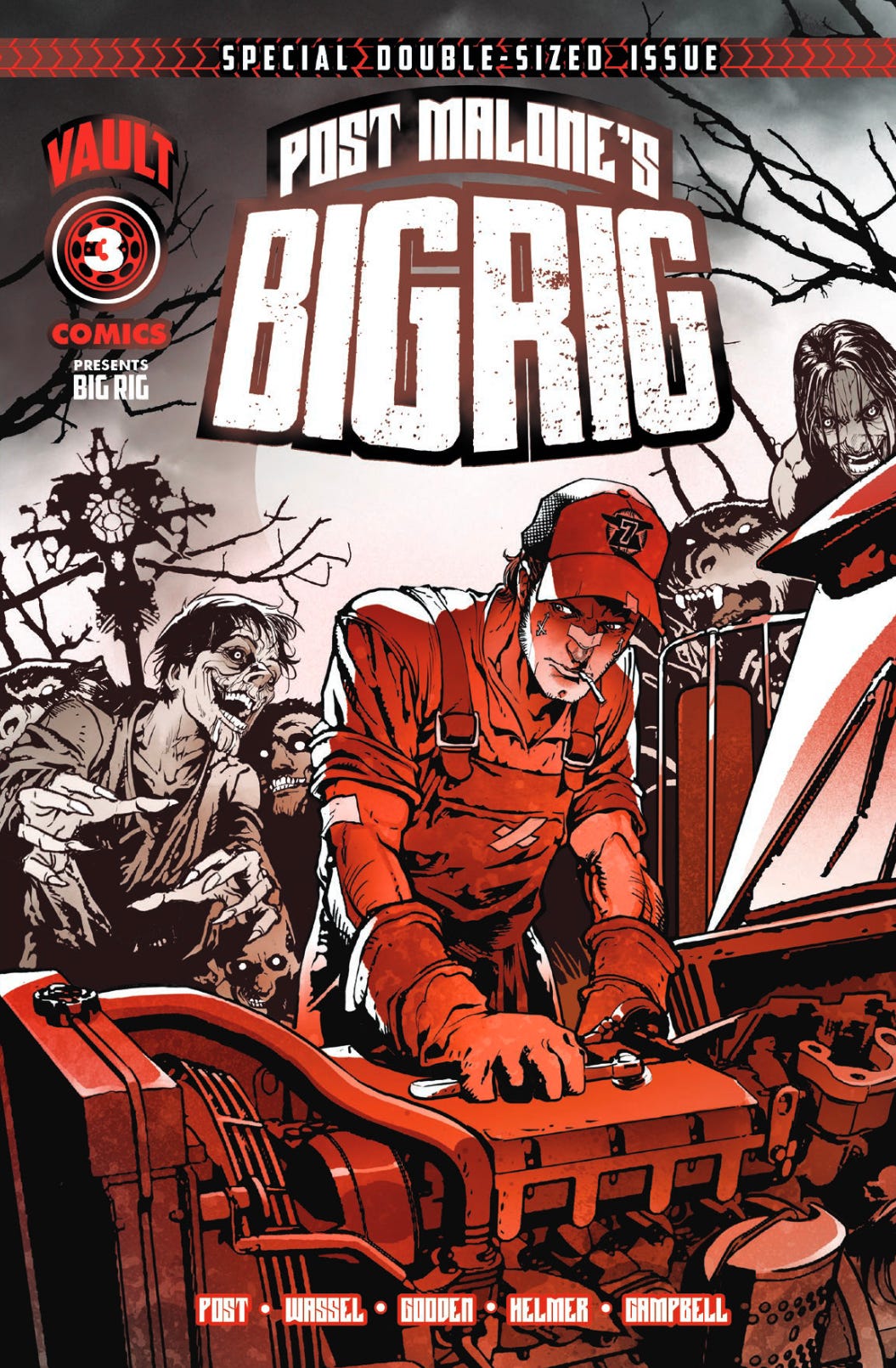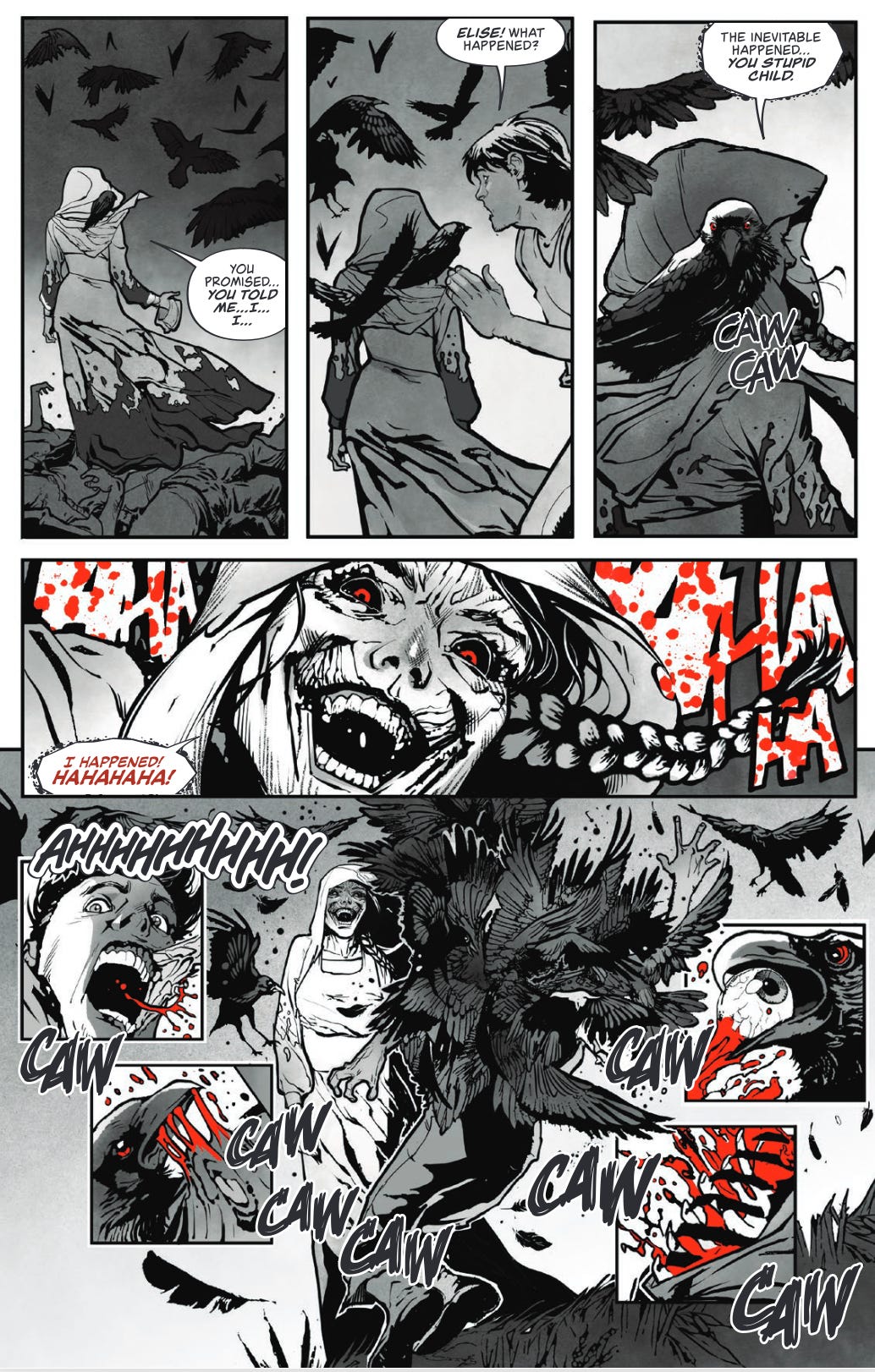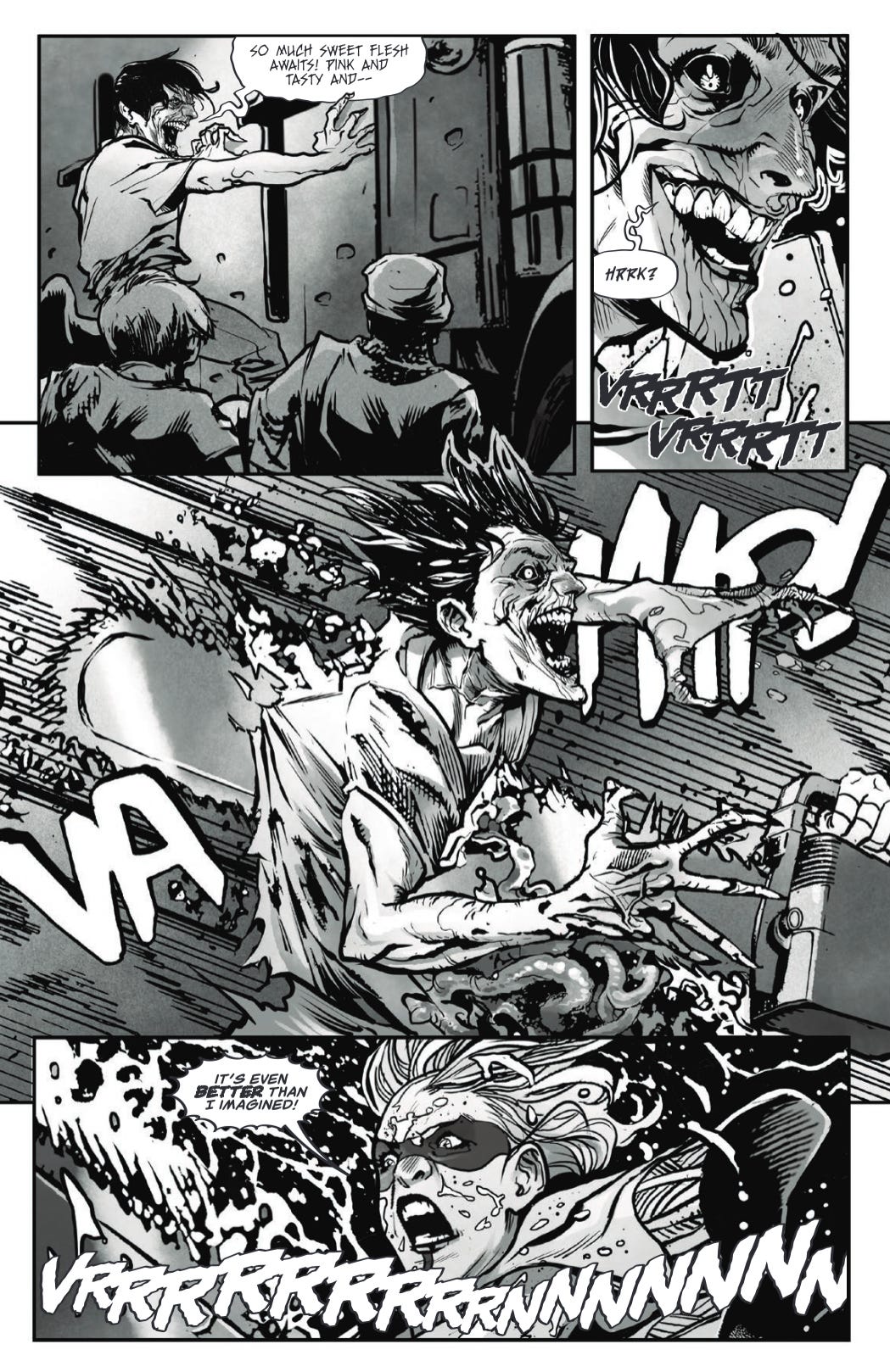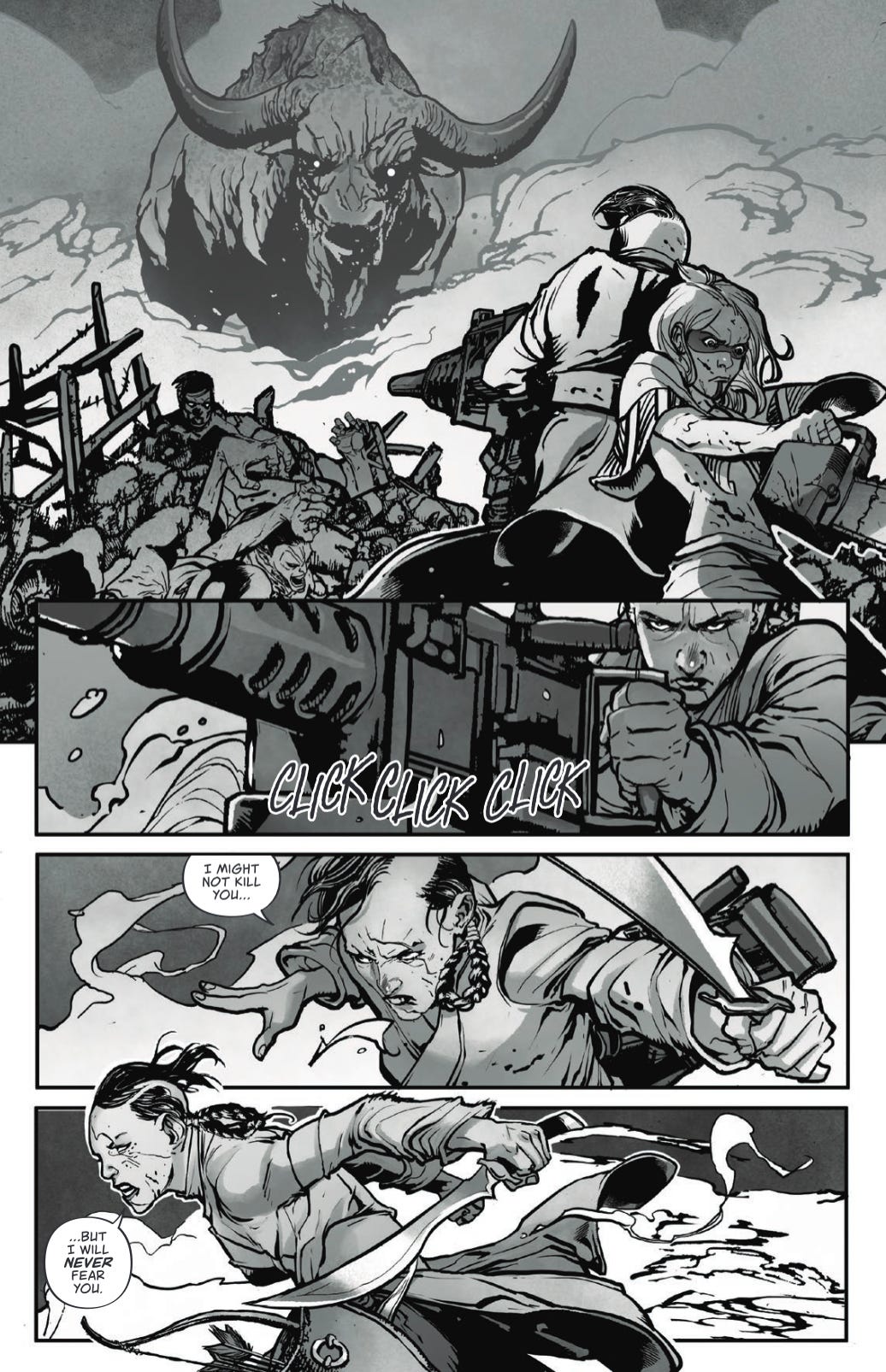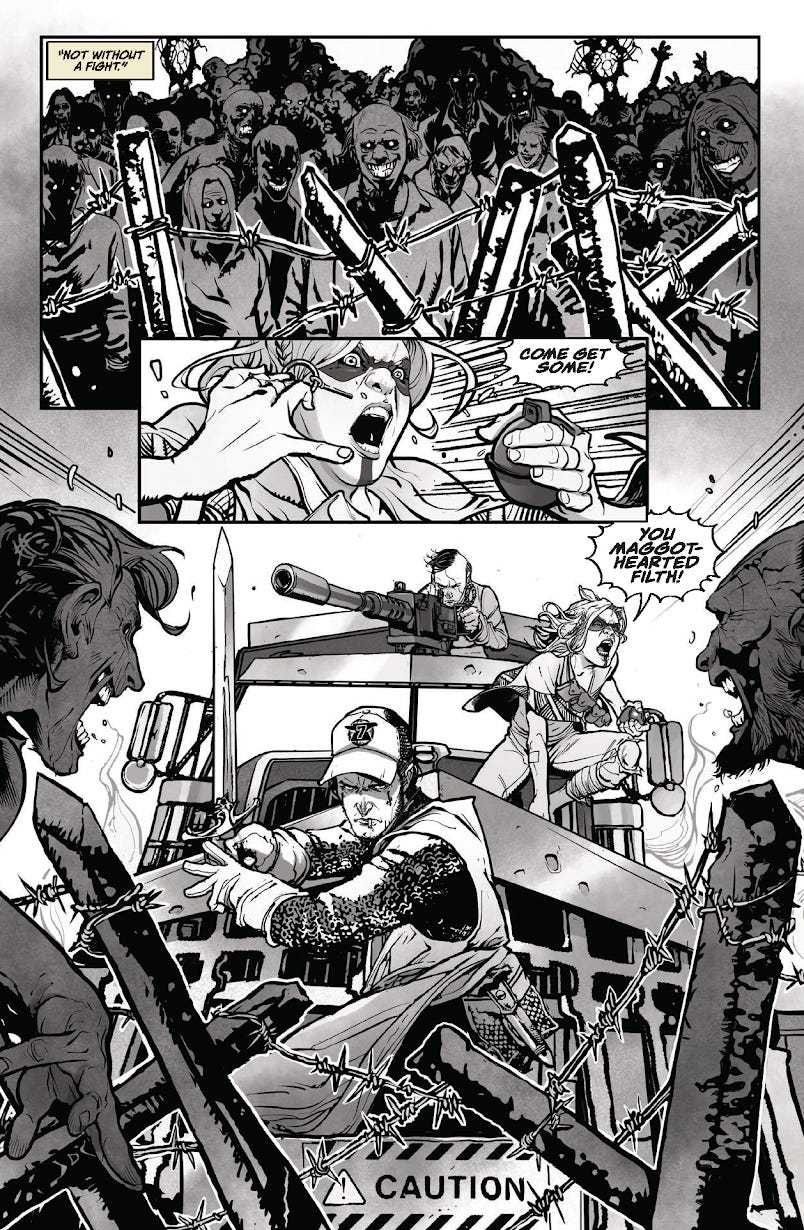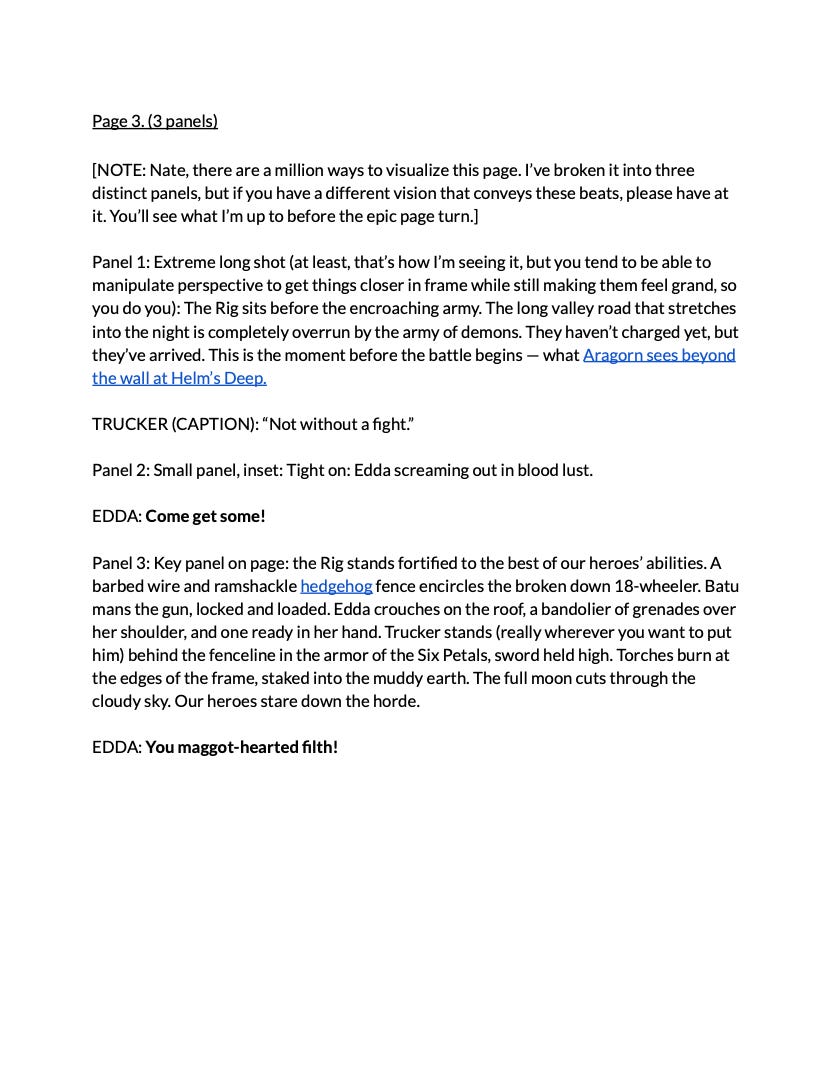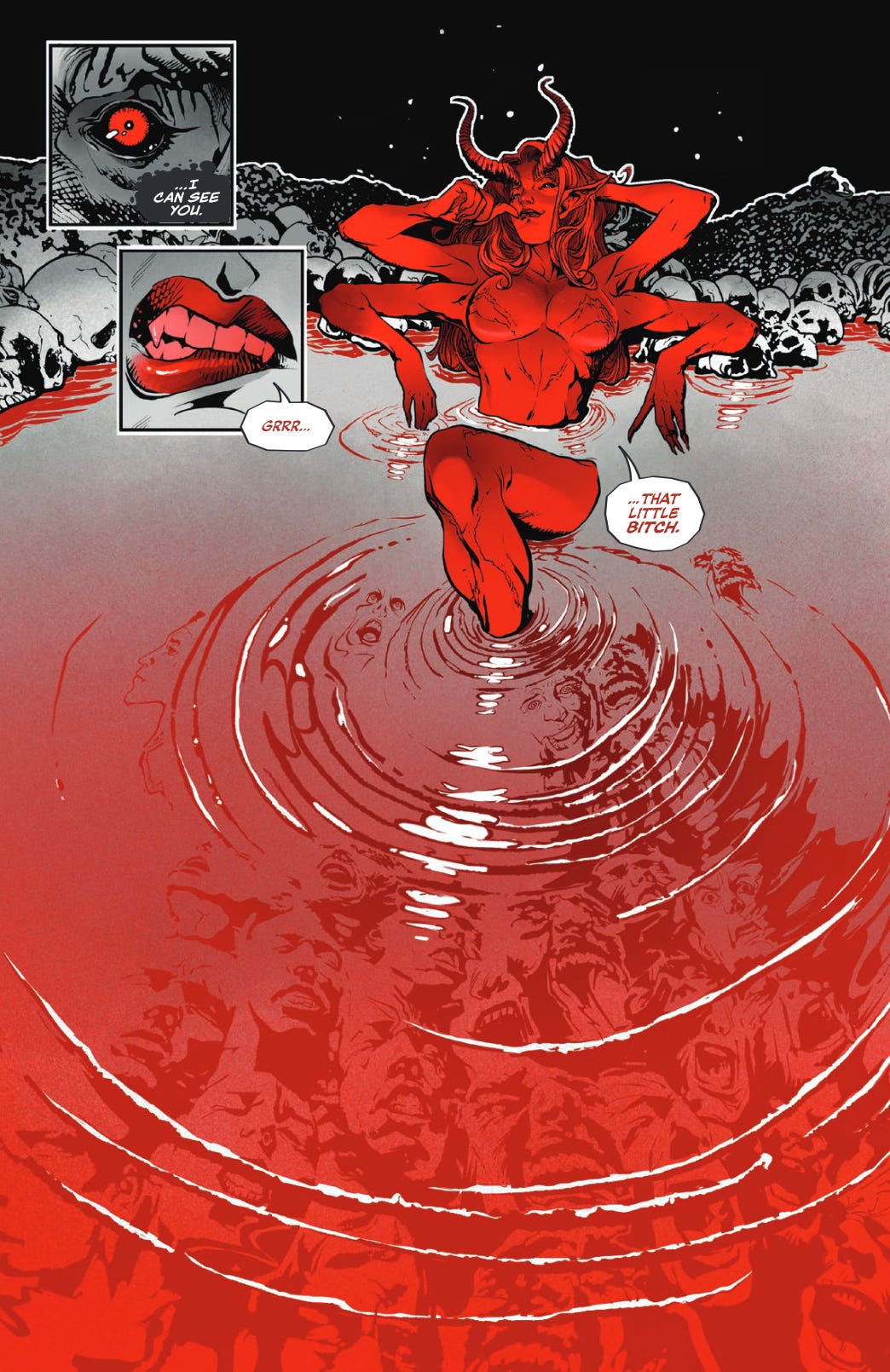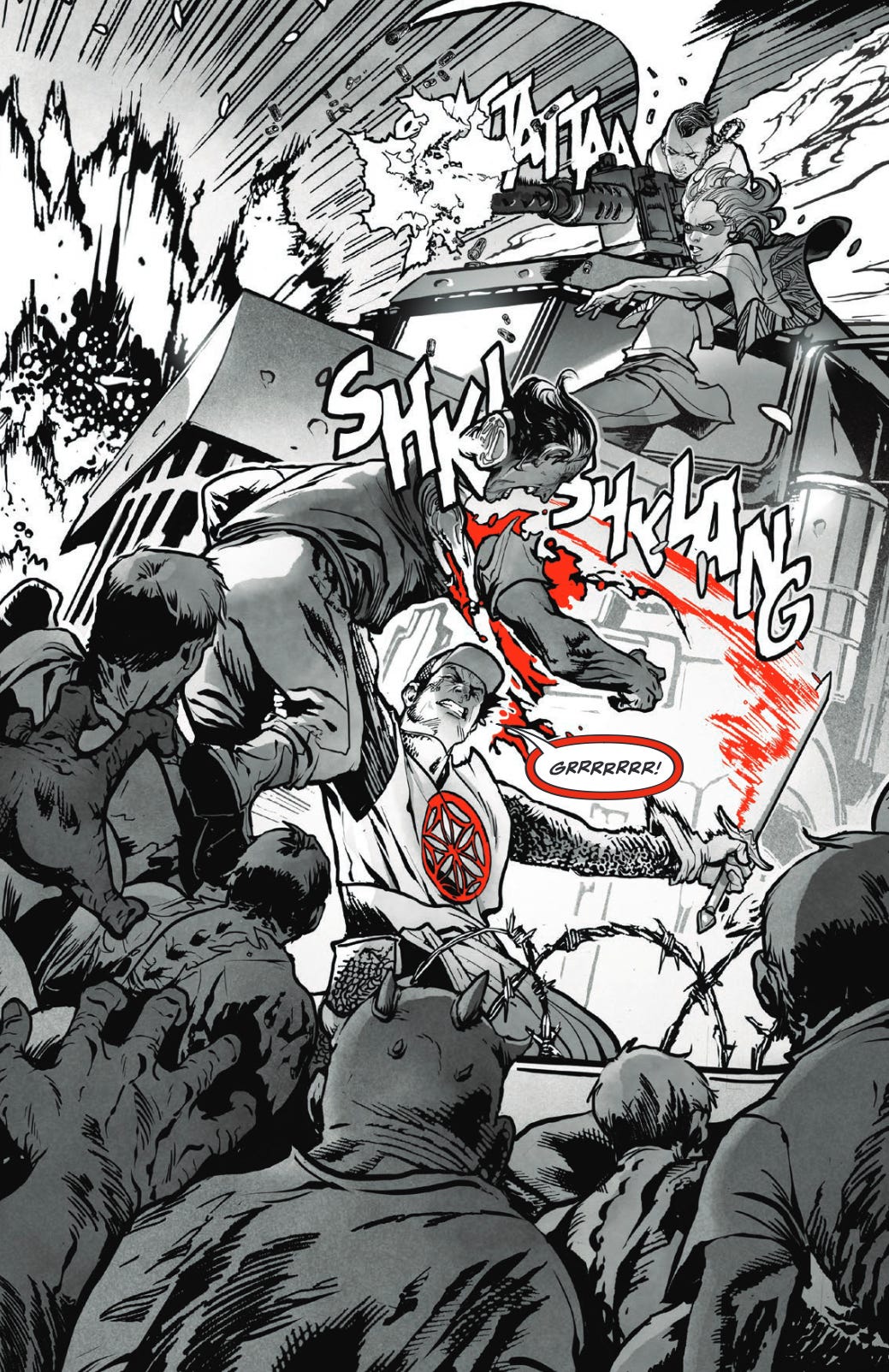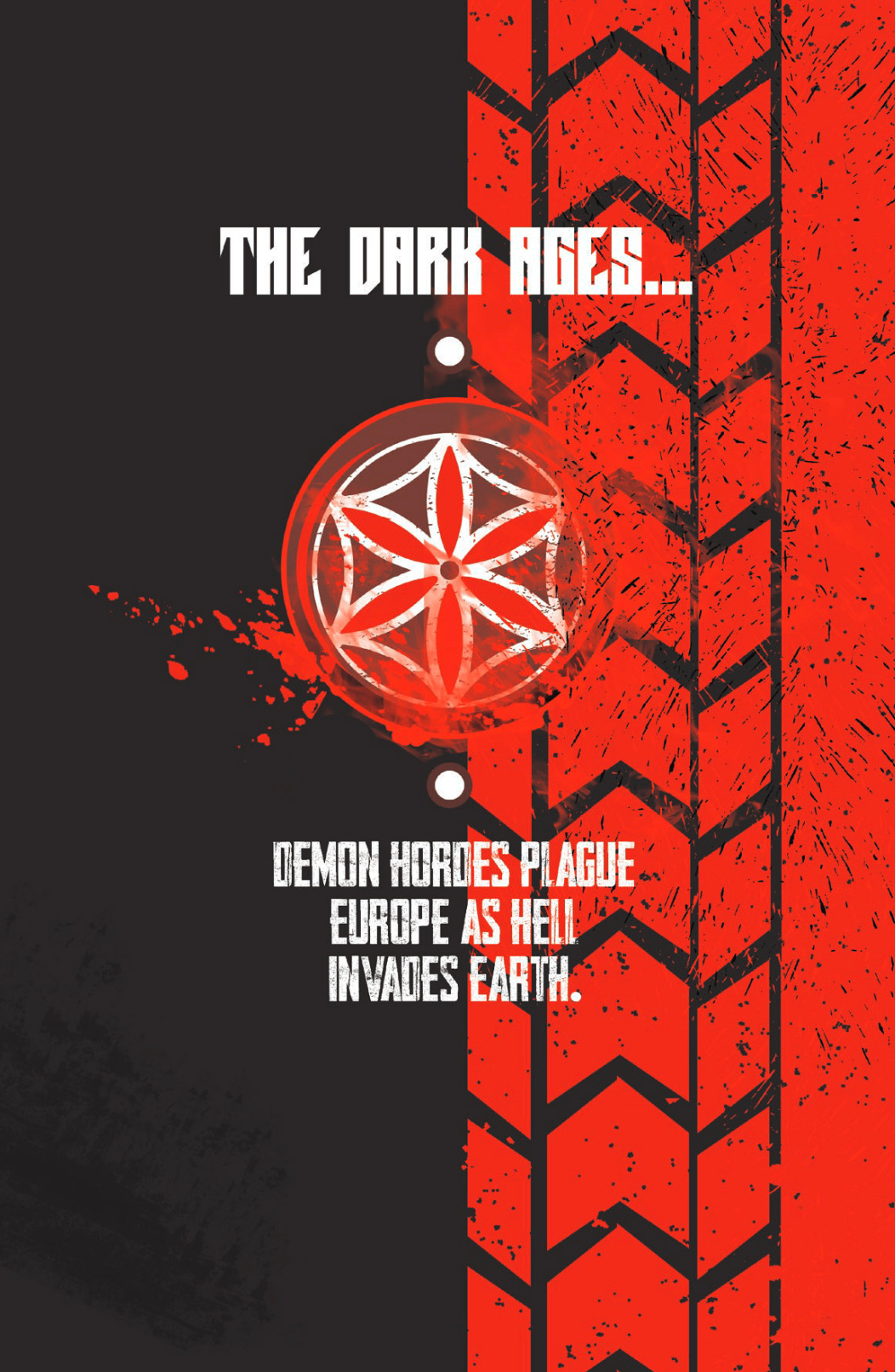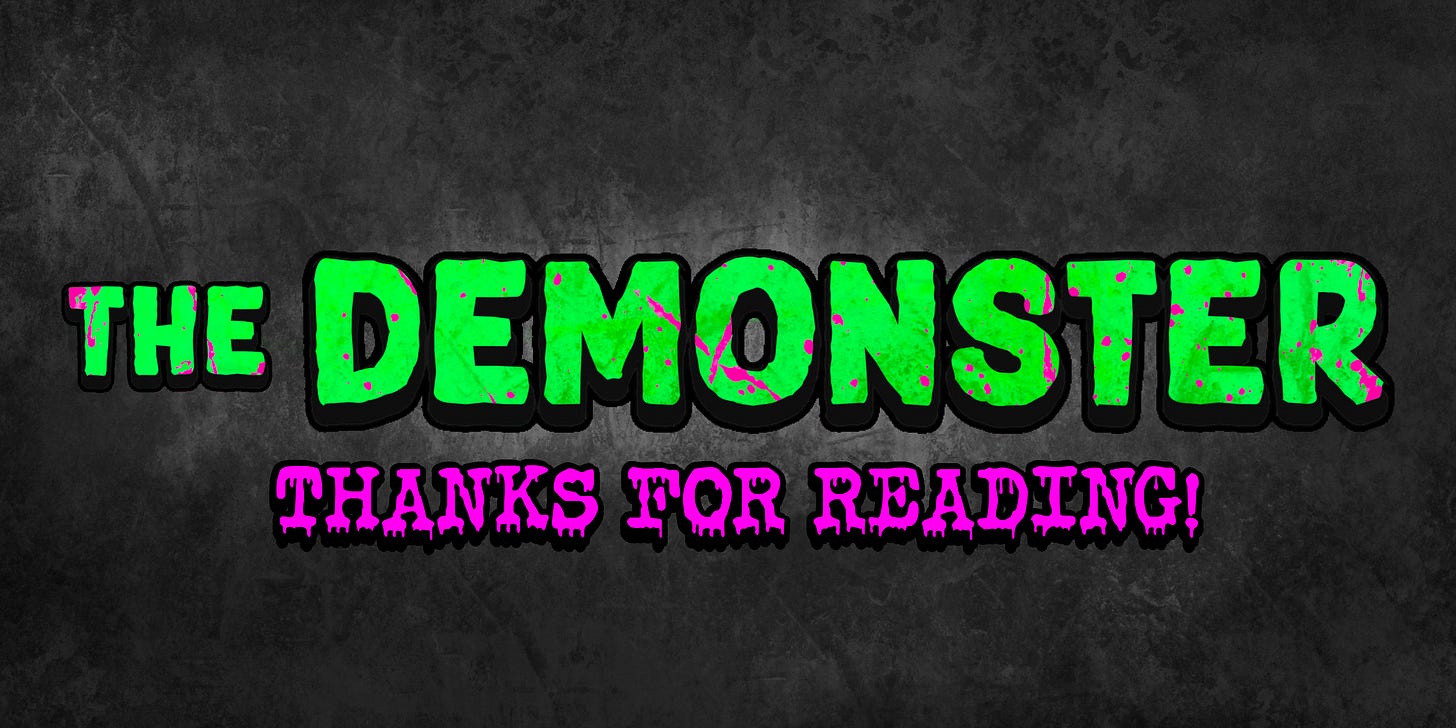Guts, Gore, and an 18-Wheeler in “Post Malone’s Big Rig” [Interview]
Interview with co-writer Adrian Wassel.
Post Malone’s Big Rig is a chaotic and gory action-horror series that throws an 18-wheeler semi-truck into medieval Europe to fight hordes of bloodthirsty demons. This high-octane series defies genres and keeps readers on their toes as we follow an excommunicated priest, a Viking witch, and a bad-ass Mongolian archer fighting their way through a demon-apocalypse that has crippled the entirety of world.
Post Malone teams up with Vault Comics editor-in-chief Adrian Wassel and Barbaric co-creator Nathan Gooden to deliver a series that’s like Army of Darkness meets Mad Max Fury Road. Post Malone, Platinum Dunes, and Vault Comics are already developing a feature film with director Michael Bay.
The Dark Ages...Demon hordes plague Europe as Hell invades Earth. The Six Petals, a secret sect of The Knights Templar, are in desperate need of a means to drive back the scourge and turn the tide of the onslaught. What crashes to earth is The Rig, a fully loaded tractor trailer. In the aftermath of its arrival, the only man left standing is an enigmatic former priest excommunicated from The Six Petals. He will become Trucker and lead the fight against Hell behind the wheel of a demon-slaying machine.
Each over-sized issue of Post Malone’s Big Rig consists of two chapters. Issue #3 came out this Wednesday on October 1st, containing chapters V and VI. The DeMonster got to chat with co-writer Adrian Wassel to talk about the blood-soaked series’s latest issue! From choreographing demonic fight scenes to the research that went into the historic aspects of the series, here is what Wassel has to say. Spoilers ahead.
What inspired Post Malone’s Big Rig? What was it like coming into this project and creating this insane story with Post Malone and artist Nathan Gooden?
Posty had the idea! I was lucky enough to meet him, and we sat down together in person and started chatting. He had copies of Barbaric on the table. He asked me if I thought Nathan might want to draw BIG RIG. He asked if I played Magic: The Gathering. He ran and grabbed me a beer. We talked about video games, Blade, and Thor. We hit it off—jamming on all sorts of crazy ideas—and at the end, he asked, “So you’re going to write this with me, right?”
I felt some serious imposter syndrome at that moment. It sounds stupid when it’s literally the guy asking, but we live in a judgmental world—we’ve all experienced it. And for most of the last decade, I’d poured all of my creative efforts into helping other peoples’ dreams make the page. I’d put down my pen and given it all to editing. I worried: Should I do it? Could I do it?
But Vault only exists because once upon a time, Nathan, Damian and I self-published some of our own comic books and realized that we’d built the infrastructure to support other amazing creators—creators we’d met at cons who had stories we wanted the world to see.
Then Nathan said, verbatim: “Screw the haters. I want to work with you again, too.” (Well, maybe not verbatim; you can guess what word he used instead of “screw.”)
That was all I needed to hear.
This series balances humor with horror and action, as well as balances modern day elements like a semi truck and modern dialogue with the setting of medieval Europe—what was it like creating the unique tone of the series?
It was an enormous amount of work. Luckily, I’m sort of a history nerd. I can’t hold my own against a true history buff, but I read a lot of history, and I had my era about a decade ago when I was obsessed with the Middle Ages. This really helped because while we took some serious liberties and collapsed several centuries into one era, I was able to offer—despite the liberties taken—a mental map for Nate and Posty to work from. We were careful to fill the book with lots of details that are period-accurate / historically-accurate—from games characters of different ethnic backgrounds play to the sigils different knights wear, and more.
That foundation let us feel like we could convince readers to suspend their disbelief and just have fun once the Rig crashed. For instance, writing the whole book in Middle English would have been possible. Dorky fact, I can recite entire sections of Chaucer, and even got to read from one of Chaucer’s original manuscripts while studying at university—which, for the record, has never gotten me a date. But who would want to read that? So why get caught in that middle ground of “thou” sneaking into dialogue, meanwhile its modern English? Instead, we went with fun and accessible to all readers.
We see a lot of powerful characters from all different backgrounds, like paganism, and of course, Catholic mythos is a core part of this story. What research did you put into representing these different cultures, religions, and histories? How do you honor them?
I’ll pick up right where I left off in the last answer: a lot of research. Too much maybe. Our editor, Der-shing Helmer, said I should release the research pile someday (which the team all gets to see in the scripts) to the public. But I think maybe Der-shing and I are too nerdy to know what everyone would actually want to see. That’s why we have Posty and Nate.
The hardest character for me was Batu. As a Westerner with a Western education, who studied the classics (lots of Latin for this boy), I went in with a solid base of history for John / Trucker’s ethnic, geographic, and religious context. Edda’s character was fun because everyone has recently become obsessed with Vikings, so there are a ton of great books and resources out there on Norse and Scandinavian history (go check out Vinland Saga and all the cool history in the back of that manga series!). But Batu is a Mongolian horse-archer who ends up in Europe. Constructing how and why that happened was tough—and also really fun. But if I talk about it too much, I’ll be spoiling stuff for future issues.
This series is incredibly visual, from a semi truck sent from the heavens in medieval Europe, to the gnarly demons and the gore that splatters the pages—what is the process like creating these visuals with Post Malone and Nathan Gooden? *I’d love to show off a page of a script vs the final page if you’d be willing to share and discuss it!
Post has a visual mind. He supplied so many cool scenes and locations. And Nate is among the best living artists—no question. Which means I was spoiled.
Where my brain kicks into overdrive is creature design and action choreography.
All of the action sequences in the comic were tightly panelled. Nate already had his work cut out for him drawing something as massive, detailed, and rigid as the Rig page after page. Where I knew I could help him and Post was my knowledge of how to freeze a frame to create the illusion of motion in a medium where no motion exists. Editing millions of words of comic scripts and hundreds of thousands of pages sure helped hone that skill. I blocked out intricate—and hopefully engaging—action sequences so that Nate didn’t need to act as the choreographer of our action, when his job as artist already has him acting as the director.
The creature designs were the most fun. Nate and I are both lifelong horror nerds. We play a ton of the same video games, love tons of the same manga and anime, and read lots of the same comics. So, our inspirations were myriad…but also, we were in lockstep. Post cut us loose to design whatever disgusting demonic beasts we could dream up. So we mixed elements of classic possession horror (think: Evil Dead) with mundane, everyday creatures (you’ll see designs evoking snails, bulls, centipedes, etc.). And then we took a hefty dose of Dark Souls, Gantz, Silent Hill, etc. and injected it into our world.
.
Lucifer! Lucifer is a woman! I like this a lot. What was the creative process behind this decision?
Oh, I have to be really careful not to spoil anything here! Lucifer is the rebel—never satisfied with being ruled. So, in short, her character is very much a bad guy, but if we’re lucky enough to keep getting lots of issues, you’ll see that she may not be the devil you expect. Also, action-horror is so often plagued by the damsel in distress trope, or just one clichéd badass lady on a team of a bunch of dudes. Trucker, on the other hand, is surrounded by women with complicated and messed up back stories—even his antagonist, Lucifer.
Are we going to see how the demon-apocalypse started? Is that something down the line we can expect to see in the main storyline or any spin-offs that might be announced?
In a word, yes.
Issue 3 gives us some high-stakes action and gore. What has been your favorite part of the story so far? Is there anything you want readers to take away?
Chapter V was the sequence I’ve had in my head since the very first conversation with Post. While I was busy scripting the first four chapters, it was the extended battle that would consume my thoughts while I was out running or skiing or mountain biking (I live in Montana, so when I don’t have my nose pressed into books, I play in the mountains).
That said, Chapter VI is my favorite. It’s the most ambitious chapter and certainly the one I’m most nervous about. It throws readers for a loop, intentionally. Then takes its time to explain things. We’re putting a lot of faith in our readers, and they deserve it. Comics readers are smart and voracious—I believe they want us to take risks.
As for what readers should take away…I don’t love talking about what I want people to get out of a story. I think that art comes before the agenda. I just hope readers stick with us and trust us—we are well aware that we’re skipping answers to BIG questions. Those answers will come…in time. Slowly but surely, everyone will learn how and why our main characters fit together.
Trucker fully suits up in issue #3! Can you break down the elements of his costume design and what it all means?
I actually cannot break down what it all means because some of it is really important later on to our characters’ backstories. But I can certainly get into some of it. Trucker’s vestments of war are modelled after the real vestments worn by the Knights Templar. The key difference is that the sigil he wears is for our entirely fictional sect of knights called The Six Petals. Their sigil is a six-petal rosette, which was used across cultures and religions for millenia, for the simple reason that it is a striking pattern you can make with a single circle stamped repeatedly. The six-petal rosette was almost ubiquitously associated with magic. From Poland to Ukraine to Galicia to just about anywhere, you can find the six-petal rosette inscribed on ceiling beams, musical instruments, grave stones, you name it. It is often seen as a symbol of protection, but also as a symbol of a threshold, where someone might pass from one place to another—or possibly from one world to another (hint hint).
New city, new politics, new problems, and the group is divided! What can you tease about issue 4?
Issue #4 will conclude the first arc. It moves fast and pulls together a lot of threads quickly—we keep the pedal down. But, I promise, it has some big surprises in store, too.
If you were to make a playlist based off of Post Malone’s Big Rig, may that be books, comics, shows, movies, games, music—what would be on that list?
Evil Dead, Mad Max: Fury Road, Blade, Fury, Masters of the Air, Brand New, Cherry Flavor, Silent Hill, Gantz, Chainsaw Man, Berserk, Barbaric, Doctor Strange & Doctor Doom: Triumph & Torment, Hellboy: Seed of Destruction, Lilith, Zeal & Ardor: “Run”, Torche: “Grenades”Paramore: “All I Wanted”, and Explosions in the Sky: “The Only Moment We Were Alone”.
Follow Adrian Wassel on socials at @AdrianWassel to stay up to date with his latest projects. You can find “Post Malone’s Big Rig” issue #3 at a comic shop in your area now! Keep an eye out for issue #4 dropping next month, which will conclude the current arc
.



